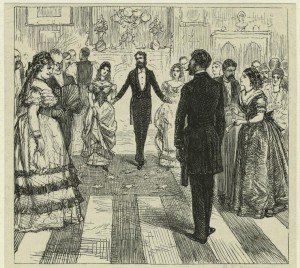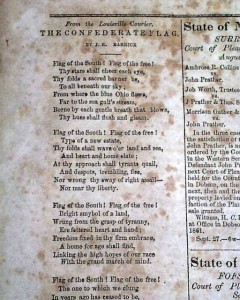Cherished and despised Civil War banners
By James Breig
A recent post examined how, during the Civil War 150 years ago, the U.S. flag became more beloved in the North and deeply despised in the South. At Gettysburg, Shiloh, Vicksburg and other battles, the Union troops marched proudly beneath Old Glory, while their Dixie opponents had their own banner to cherish.
How much some southerners came to hate their old flag is demonstrated in a story and an illustration that showed people literally dancing on the Stars and Stripes.

In “A Popular History of the United States,” author William Cullen Bryant related the following story in his accounts of the War Between the States: “The Christmas holidays [of 1862] were approaching and there was much hilarity in Murfreesborough [Tennessee]….There were wedding festivities, at one of which…the guests danced upon a floor where the hated Union flag served for a carpet, that it might be literally and boastfully trampled upon.”

Of course, hatred flowed in both directions. The Union troops did all they could to seize and destroy the emblems held dear by their opponents. How dear was captured in an 1861 poem, “The Confederate Flag,” which began with these lines:
Flag of the South!/ Flag of the free!/Thy stars shall cheer each eye,/
Thy folds a sacred banner be,/To all beneath our sky./
From where the blue Ohio flows,/Far to the sea gulf’s stream,/
Borne by each gentle breath that blows,/Thy hues shall flush and gleam.
In May 1863, The Memphis Daily Appeal said the Confederate flag “has waved triumphantly over so many battle fields in this war for Southern independence.”
The article described a new version, approved by the secessionist senate, that moved the crossed stars to the upper left of the banner to represent the states that had left the Union. The remainder of the flag (called the fly) “consists of three horizontal bars of equal width, the center bar blue, the others white.”
The white, continued the article, represented “purity and innocence,” while the blue stood for “strength and stability.”
Having passed the senate unanimously, the Daily Appeal reckoned that it would “meet with like favor in the house of representatives.” But the final version, called “The Stainless Banner,” removed the blue stripe and left the fly pure white.
It would be altered when officers complained that “The Stainless Banner” looked like a flag of surrender, rather than pride.
